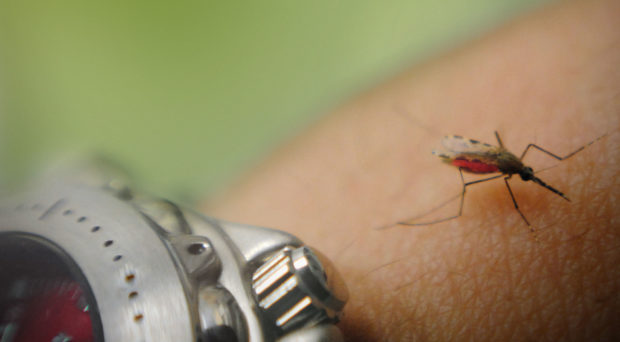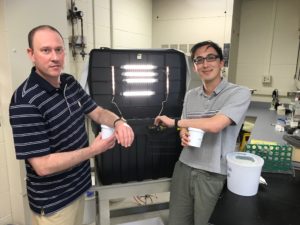
As I start to draft this blog post for BugBitten, I am sitting in a tent in the Scottish highlands, trying very hard to not get “bug bitten” by the infamous Scottish Midgie (Culicoides impunctatus). This is a far cry from my and co-investigators’ work published this month in Parasites and Vectors which involved “blood meals (the Investigator’s arm) being offered” to as many as 500 mosquitoes a night, for several nights of experiments. These experiments were performed to increase our understanding of how light both acutely (immediately) and chronically (in the long term) is able to decrease the biting behavior of the major malaria vector, Anopheles gambiae.
In this work, mosquitoes were exposed to various lighting conditions or ‘treatments,’ and then exposed to a human arm. The proportion of mosquitoes that blood fed (which can easily be determined visually by looking through a mosquito’s clear abdomen for the presence of blood) was noted. The use of a human arm instead of alternate methods such as a membrane feeder, ensured the whole range of natural host-cues a mosquito would be exposed to in the field (e.g. volatile odors, body heat, and carbon dioxide) were available to our experimental mosquitoes. Further, by assaying for actual human biting, we assayed the actual epidemiologically relevant behavior, instead of proxies such as merely being ‘attracted’ to a human host.
In the first experiment, mosquitoes were treated with a 10 min light pulse in the early night. Following light treatment, we found an immediate suppression in the number of mosquitoes biting compared to un-treated controls. This suppression was still noted up to 4 hours after the start of light pulse, indicating both an immediate and sustained light-induced suppression in blood feeding.

In the second experiment, we demonstrated that by putting mosquitoes in the dark (for 15 min) during their normal daytime hours, there was an increased number of mosquitoes biting relative to mosquitoes kept in the light.
In the third experiment, we exposed mosquitoes at different times throughout the night to light while simultaneously allowing them the opportunity to feed. We find that throughout most of the night, the presence of light inhibits blood feeding, however as the night progresses, this effect diminishes.
In our final biting experiment, mosquitoes were repeatedly pulsed every 2 hours with pulses of light throughout the night. Biting during the intervening dark periods was assessed and indeed, the “Investigator’s Arm” received less bites at every time point throughout the night than un-treated time-matched controls, but with the effect diminishing toward the late night.
Other experiments presented in the paper addressed the effect of light upon the mosquito’s flight activity behavior. Individual mosquitoes were housed in glass tubes and activity monitored using infrared beam breaks. Potent changes in activity were observed during the light exposure and the direction of the response was dependent upon the specific time of the night the pulse was delivered: suppression occurred during early night, while elevation occurred during the middle and late night.
As mosquitoes and malaria parasites are becoming increasingly resistant to insecticide and drug treatment, there is a necessity for the development of innovative control strategies beyond insecticide-treated nets (ITNs) and indoor residual spraying. Our work reveals the potent inhibitory effects of light exposure, and the utility of multiple photic pulses could be an effective tool that complements established control methods.
Future laboratory work might include a determination of the optimal wavelength of light to produce a given behavioural response, and determining the optimal spacing and timing of light pulses. Further, the suppressive nature of light on mosquito biting on successive and subsequent nights of treatment, and in the constant presence of host cues should be explored. I note I would happily continue providing an “Investigator’s arm” for these important mosquito experiments. As for the Scottish midge – I’m staying in the tent.

Mosquito biting largely depends on the biting behaviour of mosquito species. Anopheles mosquitoes by large tend to bite in night only and very few bites may occur during the day time. Similar the day biters will tend to avoid biting during night (dark) time. Not only the biting but the overall behavour including flight orientation and response to stimulus also affected by light. Although it is well known but the authors have attempted to re-prove it by generating data.